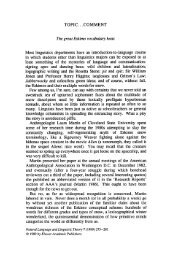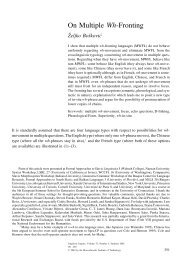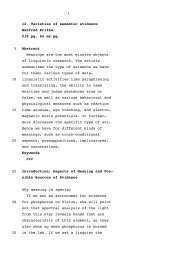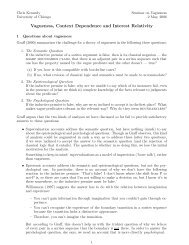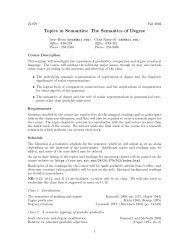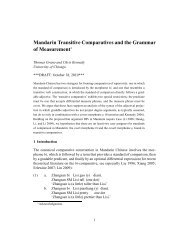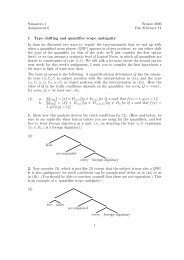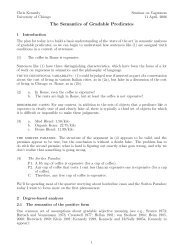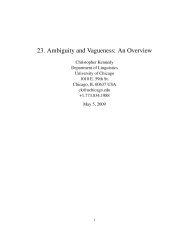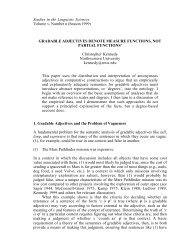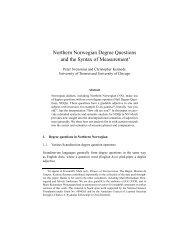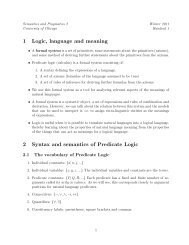On the natural history of negative polarity items - Syntax, Semantics ...
On the natural history of negative polarity items - Syntax, Semantics ...
On the natural history of negative polarity items - Syntax, Semantics ...
You also want an ePaper? Increase the reach of your titles
YUMPU automatically turns print PDFs into web optimized ePapers that Google loves.
Hadas Kotek, Yasutada Sudo & Martin Hackl<br />
Hackl assumes that in order to solve a type-mistmach, -est undergoes covert movement. He attributes<br />
<strong>the</strong> ą1/2 andsuperlativereadings<strong>of</strong>most to <strong>the</strong> scope <strong>of</strong> -est and different comparison<br />
classes C that -est takes. Roughly put, if -est moves DP-internally, a ą1/2 readingisderivedwith<br />
C set to pluralities <strong>of</strong> students closed under i-sum formation. If-est moves into <strong>the</strong> matrix clause,<br />
on <strong>the</strong> o<strong>the</strong>r hand, a superlative reading is derived, with <strong>the</strong> comparison class C comprising <strong>of</strong> all<br />
relevant individuals.<br />
(8) a. vJohn talked to most <strong>of</strong> <strong>the</strong> studentsw ô DdDXrstudentspXq ^John talked to X ^<br />
|X| ľ d ^@Y P CrY ‰ X ñ |Y| ľ dss<br />
b. C “ ˚vstudentw (9) a. vJohn talked to <strong>the</strong> most studentsw ôDdDXrstudentspXq^John talked to X^|X| ľ<br />
d ^@y P Cry ‰ John ñ DYrstudentspYq^y talked to Y ^|Y| ľ dsss<br />
b. C Ď De<br />
Adopting Hackl’s decompositional analysis, we suggest that <strong>the</strong>different readings <strong>of</strong> most are<br />
derived from different readings <strong>of</strong> many. Specifically, we propose that cardinal many is used to<br />
derive <strong>the</strong> familiar ą1/2andsuperlativereadings<strong>of</strong>most as in (8) and (9), while <strong>the</strong> RP many (1c),<br />
yields <strong>the</strong> RP superlative reading <strong>of</strong> most, and<strong>the</strong>proportionalmany yields <strong>the</strong> fragile superlative<br />
reading. While <strong>the</strong> RP superlative reading <strong>of</strong> most follows ra<strong>the</strong>r straightforwardly in <strong>the</strong> present<br />
analysis, assuming that many has <strong>the</strong> RP semantics, <strong>the</strong> fragile reading merits some discussion.<br />
Deriving <strong>the</strong> fragility: Why does <strong>the</strong> proportional many+-est give rise to <strong>the</strong> fragile reading? We<br />
claim that this is because <strong>the</strong> proportional many is “cardinally evaluative”, as illustrated in (10).<br />
(10) vManyp As are Bsw ôr|AXB|{|A| ą rCs^r|AX B| ą sA Cs Here rC is <strong>the</strong> contextually determined standard for large proportions, and sA C is <strong>the</strong> contextually<br />
determined standard for large cardinalities relative to A. Forourpurposes,itiscrucialthatsA C is<br />
relativized to A. Noticethatwearedepartingfrom<strong>the</strong>standardtruthconditions for <strong>the</strong> proportional<br />
many, (1b),where<strong>the</strong>secondconjunct<strong>of</strong>(10),i.e.<strong>the</strong>cardinalevaluativity, is absent. However,<br />
its effect is hard to observe with <strong>the</strong> proportional many, assituationswhere<strong>the</strong>proportionaltruth<br />
conditions, i.e. <strong>the</strong> first conjunct <strong>of</strong> (10), are true are <strong>of</strong>ten oneswhere<strong>the</strong>cardinalevaluativity<br />
is also satisfied (cf. Partee 1988). However, we claim that <strong>the</strong> superlativeconstructionbringsits<br />
effects to <strong>the</strong> surface in <strong>the</strong> form <strong>of</strong> <strong>the</strong> fragility effect. To corroborate this proposal, we observe a<br />
similar context sensitivity between <strong>the</strong> cardinal many,whosetruthconditionsareequivalentto<strong>the</strong><br />
second conjunct <strong>of</strong> (10), and <strong>the</strong> fragile superlative reading<strong>of</strong>most.<br />
Consider <strong>the</strong> following sentence, whose truth conditions we assume are r|blue dots| ą sdots C s.<br />
(11) In this picture <strong>of</strong> dots, <strong>the</strong>re are many blue ones<br />
Suppose that <strong>the</strong>re are 9 blue dots, and n non-blue dots. As n increases, <strong>the</strong>re is a breaking point<br />
at which <strong>the</strong> sentence becomes false. Crucially, we observe that this pattern <strong>of</strong> judgments mirrors<br />
that <strong>of</strong> <strong>the</strong> following sentence with most under <strong>the</strong> fragile superlative construal, in <strong>the</strong> sense that<br />
<strong>the</strong>y become false in <strong>the</strong> same situations.<br />
(12) Most <strong>of</strong> <strong>the</strong> dots are blue<br />
Suppose now that <strong>the</strong>re are 9 blue dots, 4 yellow dots, 4 red dots, etc. As explained above, <strong>the</strong><br />
fragile superlative reading becomes false after 5 or 6 comparisons in such a situation. Our observation<br />
is that <strong>the</strong> point at which (12) becomes false is <strong>the</strong> samepointatwhich(11)becomesfalse.<br />
Interestingly, <strong>the</strong> judgments for (12) are also affected by <strong>the</strong> composition <strong>of</strong> <strong>the</strong> non-blue dots, and<br />
so are <strong>the</strong> judgments for (11). Suppose that <strong>the</strong>re are 9 blue dots, 2 yellow dots, 2 red dots, etc.<br />
Compared to <strong>the</strong> earlier situation, both (11) and (12) stay true with more comparisons than 5 or 6.<br />
In order to explain this parallelism, we propose that -est only operates on <strong>the</strong> proportion argument<br />
<strong>of</strong> manyp and retains its cardinal evaluativity. Thus, <strong>the</strong> truth conditions for <strong>the</strong> fragile<br />
superlative reading <strong>of</strong> (12) look as follows.<br />
(13) For all non-blue colors c, r|blue dots|{|dots| ą |c dots|{|dots|s and r|blue dots| ą sdots C s<br />
Notice that (13) entails (11), which captures <strong>the</strong> parallel judgments.



